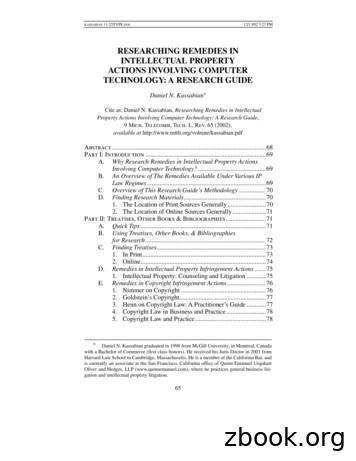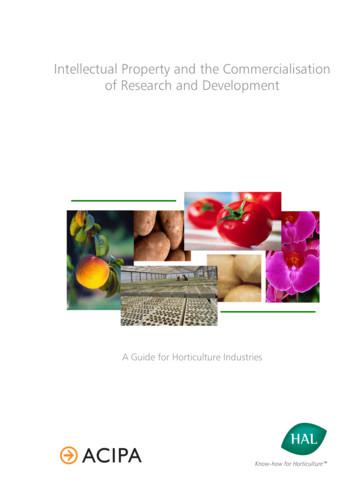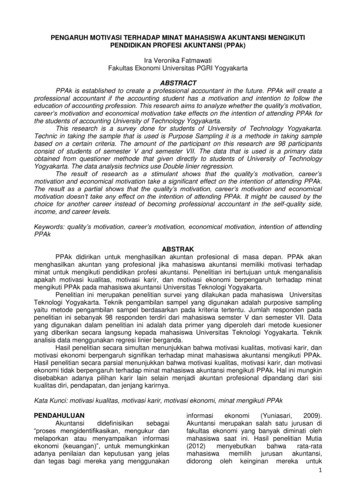RESEARCHING REMEDIES IN INTELLECTUAL PROPERTY
KASSABIAN 11-25TYPE.DOC12/13/02 3:27 PMRESEARCHING REMEDIES ININTELLECTUAL PROPERTYACTIONS INVOLVING COMPUTERTECHNOLOGY: A RESEARCH GUIDEDaniel N. Kassabian*Cite as: Daniel N. Kassabian, Researching Remedies in IntellectualProperty Actions Involving Computer Technology: A Research Guide,9 Mich. Telecomm. Tech. L. Rev. 65 (2002),available at http://www.mttlr.org/volnine/kassabian.pdfAbstract .68Part I: Introduction .69A. Why Research Remedies in Intellectual Property ActionsInvolving Computer Technology? .69B. An Overview of The Remedies Available Under Various IPLaw Regimes .69C. Overview of This Research Guide’s Methodology .70D. Finding Research Materials.701. The Location of Print Sources Generally .702. The Location of Online Sources Generally.71Part II: Treatises, Other Books & Bibliographies .71A. Quick Tips .71B. Using Treatises, Other Books, & Bibliographiesfor Research .72C. Finding Treatises.731. In Print.732. Online.74D. Remedies in Intellectual Property Infringement Actions .751. Intellectual Property: Counseling and Litigation .75E. Remedies in Copyright Infringement Actions .761. Nimmer on Copyright .762. Goldstein’s Copyright.773. Henn on Copyright Law: A Practitioner’s Guide .774. Copyright Law in Business and Practice.785. Copyright Law and Practice .78* Daniel N. Kassabian graduated in 1998 from McGill University, in Montreal, Canadawith a Bachelor of Commerce (first class honors). He received his Juris Doctor in 2001 fromHarvard Law School in Cambridge, Massachusetts. He is a member of the California Bar, andis currently an associate at the San Francisco, California office of Quinn Emanuel UrquhartOliver and Hedges, LLP (www.quinnemanuel.com), where he practices general business litigation and intellectual property litigation.65
KASSABIAN 11-25TYPE.DOC6612/13/02 3:27 PMMichigan Telecommunications and Technology Law ReviewF.[Vol. 9:65Remedies in Patent Infringement Actions .781. Chisum on Patents.782. Patent Litigation Procedure and Tactics .793. Patent Law Perspectives .804. Walker on Patents .805. Patent Law Fundamentals.816. Patent Law: A Practitioner’s Guide .81G. Remedies in Trademark Infringement Actions .811. McCarthy on Trademarks and Unfair Competition.812. Trademark Protection and Practice .823. Trademark Law: A Practitioner’s Guide.83H. Useful Treatises for Remedies in Trade Secret LitigationInvolving Technology .831. Milgrim on Trade Secrets.832. Trade Secrets Law .843. Pooley on Trade Secrets .844. Trade Secrets: A Practitioner’s Guide .85I.Treatises on Laws Applicable to Computer Softwareand Other Technology .851. Scott on Computer Law.852. Computer Software Protection/Liability/Law/Forms.863. The Law of Computer Technology.864. Computer Software Protection Law .875. Bender’s Computer Law.87J.Finding Books & Bibliographies .881. Using Library Catalogs to Find Books& Bibliographies .88K. Useful Books in 2001 .90Part III: Law Reviews, Periodicals, Annotated LawReports & Restatements.91A. Quick Tips .91B. Using Annotated Law Reports, Periodicals, &Restatements For Research .911. Finding ALRs Dealing with Remedies inIntellectual Property Actions .912. Finding Periodical Articles.923. Restatements.95Part IV: Statutes & Legislative History.96A. Quick Tips .96B. Using Statutes and Legislative History for Research.97C. Finding Relevant Statutes and Legislative History .97D. Copyright Law: Remedial Statutes and TheirLegislative History .99
KASSABIAN 11-25TYPE.DOCFall 2002]12/13/02 3:27 PMResearching Remedies in Intellectual Property Actions67The Semiconductor Chip Protection Act: RemedialStatutes and Their Legislative History.101F. The Patent Act of 1952: Remedial Statutes andTheir Legislative History .102G. The Lanham Trademark Act of 1946: Remedial Statutesand Their Legislative History.103H. The Anticybersquatting Consumer Protection Act:Remedial Statutes and Their Legislative History.103Remedies Available Under State TradeI.Secret Legislation.104Part V: Case Law .104A. Quick Tips .104B. Using Case Law For Research.105C. Finding Case Law .1051. Searching Online Versus Searching in Texts .1052. Online Databases on Westlaw .1063. Using West’s Key Number System.1074. Searching for Cases on Westlaw Using BooleanTerms and Connectors .1115. Online Databases on LEXIS.1116. Using Lexis’s Core Concepts and CoreTerms System .1127. Searching for Cases on LEXIS Using BooleanTerms and Connectors .1138. Searching for Cases on Westlaw or LEXISUsing Natural Language Searching.113Part VI: Litigation Materials.114A. Quick Tips .114B. Finding Litigation Updates, Brief Reporters & OtherLitigation Materials .114C. Using Litigation Updates, Brief Reporters, &Other Litigation Materials.115D. Searching Litigation Updates, Brief Reporters, & OtherLitigation Materials .115E. Current Litigation Reporters & Brief Reporters.1161. Andrews Computer & Online IndustryLitigation Reporter .1162. Andrews Intellectual Property Litigation Reporter .1163. Mealey’s Litigation Report: Intellectual Property.1174. Mealey’s Litigation Report: Patents .1175. E-Commerce Law Report.1176. Derwent LitAlert .1187. Intellectual Property News .1188. BNA Patent, Trademark & Copyright Law Daily .118E.
KASSABIAN 11-25TYPE.DOC6812/16/02 11:38 AMMichigan Telecommunications and Technology Law Review[Vol. 9:659.10.11.12.BNA Patent, Trademark & Copyright Journal .118Westlaw Topical Highlights—Intellectual Property .119The Brief Reporter .119U.S. Supreme Court Briefs & CaliforniaSupreme Court Briefs.119Part VII: Citation Services & Update Services.119A. Quick Tips .119B. Using Citation and Update Services For Research.120C. Using Citator Services For Legal Research.1201. Westlaw’s KeyCite Service.1202. LEXIS’ Shepard’s Citations System.121D. Example of Using Citator Services for Legal Research.121E. Using Update Services for Legal Research.1221. Westlaw’s KeyCite Alert.1222. LEXIS’ Eclipse.122Part VIII: Internet Sources Generally .123A. Quick Tips .123B. Using The Internet & Law Related Web Sites .123C. Searching The Internet & Law Related Web Sites.123D. Useful Web Sites in 2001.124AbstractThe purpose of this research guide is not to answer the question“What remedies are available to an owner of computer relatedtechnology whose rights have been infringed?” but to provide amethodology by which a legal practitioner can find the answerto this question. This guide sets forth materials and methods ofresearch that can be used for an inquiry that is broad in scope,such as researching which legal scheme’s remedial componentbest suits a client’s technology, but that are also capable of being used for a narrow or limited inquiry, such as looking forspecific remedies available in litigation to enforce a client’srights.The guide points to many useful materials that practitioners inthe field of intellectual property will find very helpful. The article will prove to be an invaluable resource to those doingresearch in the area of intellectual property for the first time,and to those law office librarians who are looking to gatherintellectual property resources for attorneys conducting suchresearch.
KASSABIAN 11-25TYPE.DOCFall 2002]12/13/02 3:27 PMResearching Remedies in Intellectual Property Actions69Part I: IntroductionA. Why Research Remedies in Intellectual PropertyActions Involving Computer Technology?As computer technology becomes increasingly important in our everyday lives, so will the importance of the computer industry, as it relatesto the economy as a whole. Part of what will determine the growth ofthis industry is the system of laws that regulate the products it creates. Inthe United States, the laws governing intellectual property (or IP), suchas copyright law, patent law, trademark law and trade secret law, willindirectly influence the ideas, inventions and innovations arising fromthis digital age. The right of inventors or entrepreneurs to control andkeep ownership of their intangible work, as set forth in these laws, is akey element in determining the extent to which innovation will occur.And as with any right, the scope of the remedies set forth to enforce thisright of ownership and control underlie the strength of the right. Thus,knowing what remedies are available to inventors and entrepreneurs inthis digital age, which set forth the disincentives that prevent others frominfringing on these inventors or owners rights, is one of the most important aspects of the system of intellectual property laws.The purpose of this research guide is not to answer the question“What remedies are available to an owner of computer related technology whose rights have been infringed?” but to provide a methodology bywhich a legal practitioner can find the answer to this question. Thisguide sets forth materials and methods of research that can be used forboth a broad inquiry, such as researching which legal scheme’s remedialcomponent best suits a client’s technology, and a narrow inquiry, such aslooking for specific litigation remedies to enforce a client’s legal rights.B. An Overview of The Remedies AvailableUnder Various IP Law RegimesIP law, like other areas of law, sets forth two main types of remediesfor the infringement of someone’s rights: money damages and injunctiverelief. However, the scope of the injunctive relief available, and the determination of those money damages, depends both on the type of IP lawbeing applied, and its relationship to the disputed computer technology.Although copyright law, patent law, trademark law and trade secret laware all rooted in the notion that the intangible result of a person’s workshould be afforded the same protection as tangible property, the mannerin which each type of IP law achieves this objective differs tremendously. Further, computer technology in both its form and capability
KASSABIAN 11-25TYPE.DOC7012/13/02 3:27 PMMichigan Telecommunications and Technology Law Review[Vol. 9:65have such a scope that it has made all four of these separate regimesrelevant to a legal practitioner dealing with this technology. For instance,software can be considered a literary work worthy of copyright protection, yet also be part of an integral process entitling it to patentprotection. Further, instead of both or either of these protections, it couldalso be afforded trade secret protection. A practitioner must be aware ofthe remedies available under all of these legal schemes when decidinghow to protect the software from theft. Thus, this guide provides methods to conduct research for each of these sets of laws.C. Overview of This Research Guide’s MethodologyThis research guide lays out the different avenues of research in thetypical order that research in this field should be conducted. Chapter IIrefers to treatises, which often provide a great starting point for research,since they examine the law as a whole and set forth the relationship between statutes and case law in the area. Chapter II also provides a briefoverview of searching for books that may be of use to a practitioner.Then, chapter III refers to periodicals and related publications, whichcan be used to provide a more recent analysis than treatises or books.Chapter IV deals with statutes, the backbone of IP law. Chapter V analyzes case law, which is a core part of legal research in this field. ChapterVI looks at litigation research and how to find the outcomes in similar IPcases. Chapter VII deals with citation services and update services,which can be used to supplement and update case research. Finally,chapter VIII examines the use of the internet to find web sites dealingwith IP damages. Although research should follow this order generally,practitioners with expertise in the area, or with a narrow purpose, mayfind it useful to refer to one chapter in particular. Also, to aid practitioners seeking to use this research guide as a reference, the beginning ofeach chapter contains a Quick Tips section designed to give a quickoverview of the chapter and the methods explained therein.D. Finding Research Materials1. The Location of Print Sources GenerallyAlthough this guide sets forth in specificity what print sources aremost useful for research of remedies for IP actions involving computertechnology, practitioners planning on specializing in this area shouldbecome familiar with their library’s holdings of print sources in this areamore generally. If the library employs Library of Congress (LC) numbering, there are generally two areas that will be of interest to researchers.
KASSABIAN 11-25TYPE.DOCFall 2002]12/13/02 3:27 PMResearching Remedies in Intellectual Property Actions71First, KF390 and KF390.5 contain, among other things, publications regarding “computer law,” loosely defined as laws that govern technologyrelated to computers.1 Second, IP law is generally cataloged fromKF2972 to KF3197, in the order of copyright, patent, trademark andtrade secret materials. Most of the print sources referred to in this guidecan be found within these ranges of LC numbers. Partial LC numbers areincluded in the footnotes to aid in research.22. The Location of Online Sources GenerallyThe two online sources most used by legal practitioners are Westlawand LEXIS. Except for chapter VIII, which is devoted to internet website generally, when referring to online sources, this guide will staywithin these two sources. Both Westlaw and LEXIS have sections organized by topic, which can be useful to researchers. Relevant for this guideare the topical groupings for IP law.On Westlaw, materials useful for IP research are grouped in twoways. First, within the web site’s main directory, under Topical Materialsby Area of Practice3 is the Intellectual Property category, which lists allsources related to IP law. Second, one can customize Westlaw to includea tab called Intellectual Property at the top of the web site that is devotedto commonly searched IP related databases.On LEXIS, materials are organized into the various types of IP law.Under Area of Law—by Topic, there are a number of groupings of interest, including Copyright Law, Cyberlaw, E-Commerce, Patent Law, andTrademarks.Part II: Treatises, Other Books & BibliographiesA. Quick TipsTreatises are the best source for an overview of the differing remedytheories for intellectual property cases dealing with computer technology. Thus, they are a good secondary source with which to start research.Although there is not one great single treatise dealing with the particularsubject, a number of treatises have chapters dealing with the issue extensively. Good treatises to refer to include:1. Part of “computer law” is the law relevant to commercial transactions and the marketing of computer technology, both of which are beyond the scope of this research guide.2. The first part of the LC number is provided as a starting point in order to guide thereader within a library or within an online catalog.3. To avoid confusion, this guide has online sources, categories, databases and searchterms in italics.
KASSABIAN 11-25TYPE.DOC7212/13/02 3:27 PMMichigan Telecommunications and Technology Law Review[Vol. 9:65 Part III, Part G, chapters 90–94 of Intellectual PropertyCounseling and Litigation published by Matthew Bender.4 Vol. 4, chapter 14 of Nimmer on Copyright, published byMatthew Bender.5 Vol. 7, chapter 20 of Chisum on Patents, published by Matthew Bender.6 Vol. 5, chapter 30 of McCarthy on Trademarks and Unf
the field of intellectual property will find very helpful. The arti-cle will prove to be an invaluable resource to those doing research in the area of intellectual property for the first time, and to those law office librarians who are looking to gather intellectual property resources
Article 2. Intellectual Property Intellectual property is work of the human mind through inventions and creations. Article 3 (revised). Definitions The terms as used in this law have the following meanings: 1. Intellectual property rights mean the rights of individuals, legal entities or organizations to their intellectual property; 2.
1 Unlike copyrights and patents, which are exclusively protected by federal law, remedies for trademark infringement and trade secret misappropriation may be available under both federal and state law. This report focuses solely on federal intellectual property law. 2 U.S. CONST. art. I, § 8, cl. 8. 3 U.S. CONST. art. I, § 8, cl. 3.
of intellectual property can deal with those rights. Each of these issues is considered in detail. Enforcing Intellectual Property Rights and Related Issues Having looked at the way in which parties may choose to commercialise their intellectual property rights, Section 6 turns to the management
Intellectual Property Rights, Technology Policies, and Innovation Management, Ankara University is now offering a new graduate degree on intellectual property. Jointly organized by the . Introduction to Intellectual Property and
such Intellectual Property shall be assigned to KAUST immediately upon conception, reduction to practice, authoring or creation of the Intellectual Property, regardless of the source of funding, if any, which supported the development of the Intellectual Property. 5.2. Externally-Funded Research.
intellectual property laws that the Eastern District of Virginia is committed to enforcing." "This landmark conviction represents the latest success of ICE in targeting intellectual property thieves," said ICE Director Morton. "Through the National Intellectual Property Rights Coordination Center, ICE will continue
interchangeably with intellectual property) as including: "rights to use industrial assets such as patents, trademarks, trade names, designs or models. It also includes literary and artistic property rights and intellectual property such as know-how and trade secrets."5 In an automotive context, you might consider three key areas in which
sistem pendidikan akuntansi (Dian, 2012). Mengingat pentingnya PPAk bagi mahasiswa akuntansi maka diperlukan motivasi dari dalam diri mahasiswa terhadap minat untuk mengikuti PPAk. Minat merupakan keinginan yang timbul dari dalam diri mahasiswa untuk mengikuti pendidikan profesi, di mana minat setiap mahasiswa sangatlah beragam hal tersebut tergantung pada pribadi masing-masing mahasiswa .























